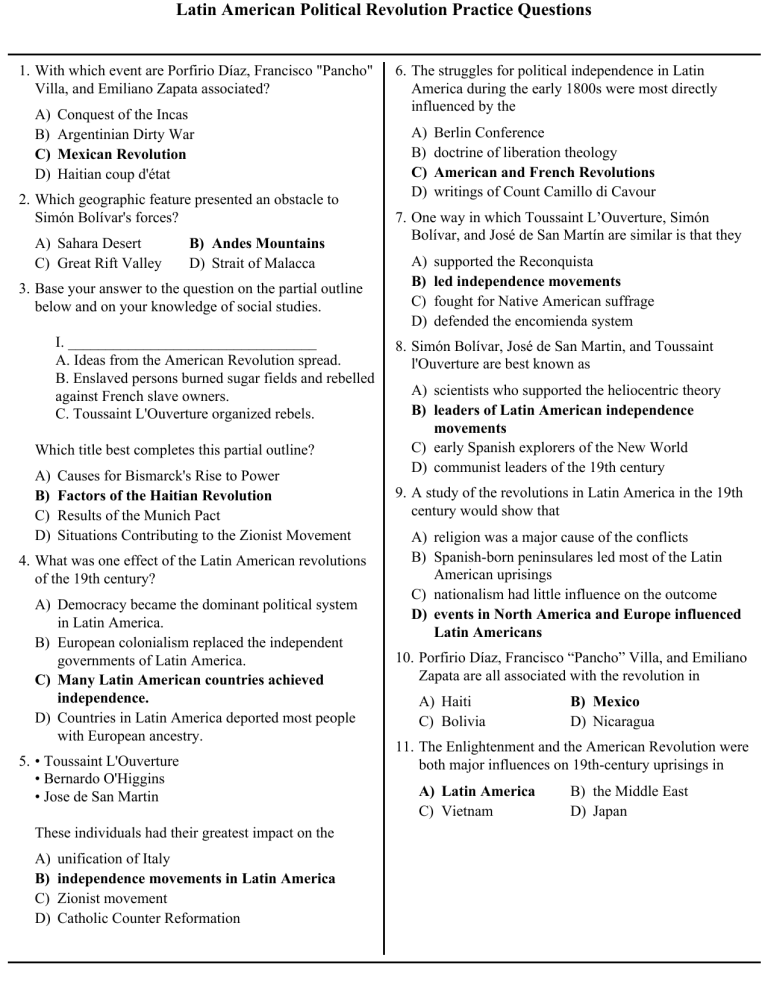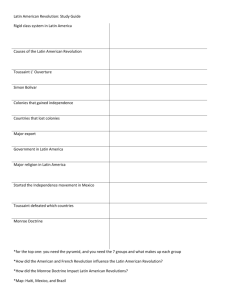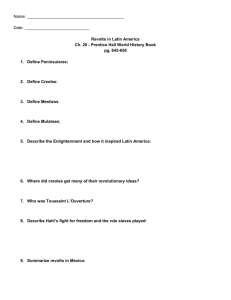Latin American Political Revolution Practice Questions

Latin American Political Revolution Practice Questions
1. With which event are Porfirio Díaz, Francisco "Pancho"
Villa, and Emiliano Zapata associated?
A) Conquest of the Incas
B) Argentinian Dirty War
C) Mexican Revolution
D) Haitian coup d'état
2. Which geographic feature presented an obstacle to
Simón Bolívar's forces?
A) Sahara Desert B) Andes Mountains
C) Great Rift Valley D) Strait of Malacca
3. Base your answer to the question on the partial outline below and on your knowledge of social studies.
I. _________________________________
A. Ideas from the American Revolution spread.
B. Enslaved persons burned sugar fields and rebelled against French slave owners.
C. Toussaint L'Ouverture organized rebels.
Which title best completes this partial outline?
A) Causes for Bismarck's Rise to Power
B) Factors of the Haitian Revolution
C) Results of the Munich Pact
D) Situations Contributing to the Zionist Movement
4. What was one effect of the Latin American revolutions of the 19th century?
A) Democracy became the dominant political system in Latin America.
B) European colonialism replaced the independent governments of Latin America.
C) Many Latin American countries achieved independence.
D) Countries in Latin America deported most people with European ancestry.
5. • Toussaint L'Ouverture
• Bernardo O'Higgins
• Jose de San Martin
These individuals had their greatest impact on the
A) unification of Italy
B) independence movements in Latin America
C) Zionist movement
D) Catholic Counter Reformation
6. The struggles for political independence in Latin
America during the early 1800s were most directly influenced by the
A) Berlin Conference
B) doctrine of liberation theology
C) American and French Revolutions
D) writings of Count Camillo di Cavour
7. One way in which Toussaint L’Ouverture, Simón
Bolívar, and José de San Martín are similar is that they
A) supported the Reconquista
B) led independence movements
C) fought for Native American suffrage
D) defended the encomienda system
8. Simón Bolívar, José de San Martin, and Toussaint l'Ouverture are best known as
A) scientists who supported the heliocentric theory
B) leaders of Latin American independence movements
C) early Spanish explorers of the New World
D) communist leaders of the 19th century
9. A study of the revolutions in Latin America in the 19th century would show that
A) religion was a major cause of the conflicts
B) Spanish-born peninsulares led most of the Latin
American uprisings
C) nationalism had little influence on the outcome
D) events in North America and Europe influenced
Latin Americans
10. Porfirio Díaz, Francisco “Pancho” Villa, and Emiliano
Zapata are all associated with the revolution in
A) Haiti
C) Bolivia
B) Mexico
D) Nicaragua
11. The Enlightenment and the American Revolution were both major influences on 19th-century uprisings in
A) Latin America
C) Vietnam
B) the Middle East
D) Japan
Latin American Political Revolution Practice Questions
Base your answers to questions 12 and 13 on for the information below
12. Which individual is most closely associated with the changes indicated on these maps?
A) Emiliano Zapata
C) Porfirio Diaz
B) Simón Bolívar
D) Pancho Villa
13. Based on a comparison of these maps of South America, which conclusion is accurate?
A) Many regions of South America gained their independence between 1790 and 1828.
B) All of South America was independent by 1828.
C) Spain continued to gain South American colonies in the 19th century.
D) Between 1790 and 1828, South American political boundaries remained unchanged except for Brazil.
Latin American Political Revolution Practice Questions
14. Base your answer to the following question on the maps below and on your knowledge of social studies.
Between 1790 and 1828, which situation helped cause the change reflected on these maps of South
America?
A) The Aztecs regained control of many areas of South America.
B) South American voters removed Spanish and Portuguese rulers from power.
C) Spain sent conquistadores to South America.
D) Enlightenment and revolutionary ideas spread from Europe and the United States to South
America.
15. ". . . Give Venezuela such an executive power in the person of a president chosen by the people or their representatives, and you will have taken a great step toward national happiness. No matter what citizen occupies this office, he will be aided by the
Constitution, and therein being authorized to do good, he can do no harm, because his ministers will cooperate with him only insofar as he abides by the law. If he attempts to infringe upon the law, his own ministers will desert him, thereby isolating him from the
Republic, and they will even bring charges against him in the Senate. The ministers, being responsible for any transgressions committed, will actually govern, since they must account for their actions. . . ."
— Simón Bolívar, 1819
16. One similarity in the actions of Simón Bolívar and
Napoleon Bonaparte is that both leaders
A) encouraged nationalism
B) relied on diplomatic negotiations
C) established a representative form of government
D) rebelled against imperialism
17. Which two revolutions most influenced 19th-century
Latin American independence movements?
A) Agricultural and Industrial
B) French and American
C) English and Russian
D) Commercial and Green
In this passage, which type of government is Simón
Bolívar proposing for Venezuela?
A) theocracy
C) democracy
B) monarchy
D) dictatorship
18. How did the French Revolution affect the Latin
American independence movements?
A) It encouraged the British to meet the demands of the people.
B) It promoted regional cooperation to solve economic problems.
C) It provided ideas for making political changes.
D) It was a model for peaceful solutions to political conflicts.
19. Simón Bolívar, José de San Martín, and Toussaint l'Ouverture are important in Latin American history because they were
A) 20th-century caudillos
B) leaders of liberation movements
C) members of the Organization of American States
(OAS)
D) winners of the Nobel Peace Prize
20. The 19th-century independence movements in Latin
America were influenced by
A) Marxist ideology
B) the Aztec wars against Hernando Cortés
C) liberation theology
D) the American and the French Revolutions
21. The Latin American leaders Simón Bolívar, Miguel
Hidalgo, and José de San Martin are most closely associated with
A) independence movements
B) Communist revolutions
C) economic expansion
D) educational reforms
22. "Juárez Defeats French Troops in Mexico"
"Bolívar Leads Revolutions in South America"
"San Martín Liberates Argentina"
These newspaper headlines refer to the emergence of
A) colonialism
C) Marxism
B) nationalism
D) mercantilism
Latin American Political Revolution Practice Questions
23. Giuseppe Garibaldi, Thomas Jefferson, and Simón
Bolívar were similar in that each
A) encouraged a spirit of nationalism in their people
B) denied voting rights to the citizens after gaining control of their nation
C) opposed the territorial expansion of the United
States
D) followed the ideas of Marx in establishing a government
24. During the early 1800s, which was a major influence on the struggles for political independence in Latin
America?
A) poor conditions in urban centers in Latin America
B) the American and French revolutions
C) the desire of the Roman Catholic Church in Latin
America to escape European control
D) demands by Latin American workers to own their own factories
25. Which was a major political change in Latin America in the 19th century?
A) The political power of the Roman Catholic Church was eliminated.
B) The right to vote was extended to all people.
C) Political power was no longer held by people of
European ancestry.
D) Strong nationalistic feelings led to many new nations.
26. In Latin America, both Simón Bolívar and José de San
Martin were leaders who
A) worked for independence
B) led Communist-inspired revolutions
C) attempted imperialistic expansion
D) advocated a return to traditional ways
27. Simón Bolívar and Miguel Hidalgo, leaders of Latin
American independence movements, were inspired by successful revolutions in
A) the United States and France
B) the Soviet Union and China
C) Cuba and Costa Rica
D) Egypt and Kenya
Latin American Political Revolution Practice Questions
28. In Latin America, Toussaint L'Ouverture, Simon
Bolivar, and Miguel Hidalgo are regarded as heroes because of their efforts in
A) conquering Indian peoples
B) leading independence movements
C) spreading Christianity
D) opposing land reform
29. The primary ideas that were the basis of the
19th-century independence movements in Latin
America came from the
A) Russian Revolution B) French Revolution
C) Spanish monarchy D) Reformation
30. Which of these situations was the direct result of the other three?
A) Nations of Latin America won independence.
B) Revolutions occurred in North America and
France.
C) The Napoleonic wars weakened Spain's power.
D) Creoles and Mestizos became discontented with
Spanish rule.
31. "I will never allow my hands to be idle nor my soul to rest until I have broken the chains laid upon us by
Spain."
This statement was most likely made by
A) a Latin American nationalist
B) a Portuguese explorer
C) a Roman Catholic bishop
D) a Spanish conquistador
32. One similarity in the leadership of Latin Americans
Jose de San Martin, Toussaint l'Ouverture, Bernardo O'
Higgins, and Pedro I was that each leader
A) opposed United States intervention in Haiti
B) led a struggle to gain freedom for the people of his nation
C) opposed membership of his nation in the League of Nations
D) established an absolute monarchy in his nation
33. In the 19th century, the independence movements in
Latin America were greatly influenced by the
A) Glorious Revolution
B) Hundred Years War
C) Boer War
D) French Revolution
34. In the 19th century, opposition to the encomienda system in Latin America demonstrated the need for
A) landholding reforms
B) trade restrictions
C) female suffrage
D) a minimum-wage law
35. In which region of the world did the American
Revolution and the French Revolution have the greatest influence during the 1800s?
A) Southeast Asia
C) South Asia
B) Latin America
D) sub-Saharan Africa
36. Simón Bolívar, Toussaint L'Overture, and Bernardo
O'Higgins were Latin American leaders of
A) economic development
B) educational reforms
C) independence movements
D) colonial expansion
37. Which event came first in Latin American history?
A) Panama regained control of the Panama Canal.
B) Simon Bolivar established Gran Colombia.
C) Fidel Castro became the communist leader of
Cuba.
D) The North American Free Trade Agreement
(NAFTA) was signed by Mexico, Canada, and the
United States
38. Which geographic factor most limited the growth of
Latin American unity of the early 19th century?
A) the region’s diverse landforms
B) most of the region’s rivers flowed north to south
C) the region’s location close to the equator
D) the region’s lack of natural resources
39. Which characteristic describes the traditional middle class family in Latin America?
A) The family unit is usually very small.
B) Adolescent girls have a great deal of social freedom.
C) The family worships its ancestors.
D) The father is the head of the family.
Latin American Political Revolution Practice Questions
40. Which generalization is best supported by a study of the history of Latin America?
A) Protection of human rights has been a major policy of most governments.
B) Foreign powers have had little influence in the area.
C) Political power has been concentrated in the hands of the landed elite.
D) Church and state have been strictly separated.
41. The varied climate and topography of Latin America have directly led to
A) the deforestation of the region
B) the development of many diverse cultures
C) overpopulation in rural areas
D) rapid political unification
42. The topography of Latin America has tended to encourage the development of
A) rapid industrialization
B) religious unity
C) democratic principles
D) regional differences
43. In many newly independent 19th-century Latin
American nations, power was often concentrated in the hands of the
A) wealthy landowners
B) corporate executives
C) Maya and Aztec officials
D) peasant farmers
44. Which factor was most important in the development of regionalism in Latin America?
A) geographic conditions that limited contact between people
B) presence of different religious groups
C) Dutch policies of colonization
D) rapid growth of many different political parties
45. Base your answer to the following question on the graphic organizer below and on your knowledge of social studies.
Which title best completes this graphic organizer?
A) Reasons for Latin American Independence
Movements
B) Impact of the Scientific Revolution
C) Causes of the Industrial Revolution
D) Results of Nationalism in Europe
46. In the traditional Hindu caste system and in the social hierarchy of colonial Latin America, the status of a person was usually determined by
A) education
C) birth
B) wealth
D) power
47. “Americans today, and perhaps to a greater extent than ever before, who live within the Spanish system, occupy a position in society no better than that of serfs destined for labor, or at best they have no more status than that of mere consumers. . . .”
This quotation, written in September 1815, represents the views of
A) Martin Luther
C) Simón Bolívar
B) Catherine the Great
D) Adam Smith
48. Which outcome was a direct result of the social structure established during European colonization of
Latin America?
A) inequalities of income and power
B) communist governments were formed in most countries
C) a small but powerful middle class that owned the land and businesses
D) family structure of native peoples was destroyed
Latin American Political Revolution Practice Questions
49. In many Latin American nations, a major effect of colonial rule has been the
A) concentration of power in a small group of landowners
B) minor political role of the military
C) equal distribution of wealth among social classes
D) economic control held by the Indian population
50. Base your answer to the following question on the timeline below and on your knowledge of global history.
According to the timeline, which period of Haiti's history had the greatest European influence?
A) 1492-1804 B) 1805-1914 C) 1915-1934 D) 1950-1986
51. In Latin America, the emphasis on the role of the military and the strength of the Roman Catholic religion have their origins in
A) ancient Indian village organizations
B) cultural exchanges with the United States
C) English practices in the New World
D) Spanish colonial rule
52. Which statement best describes the Roman Catholic
Church in most Latin American countries in the 1980's?
A) The activities of the Church are controlled by the national governments.
B) The Church has confined its activities to religious issues.
C) The Church has become active in social and human rights issues.
D) Most people see the Church as having little influence in daily life.
53. In Latin America which situation has usually resulted when military leaders seize power?
A) Democratic rule by civilian government is quickly restored.
B) Alliances are formed with Communist nations.
C) Dictatorships are established.
D) Divisions between the social classes are eliminated.
54. As independence was gained by most Latin American countries, the power once held by the King's representatives was assumed by
A) the peasants
B) labor unions
C) Maya, Aztec, and Inca rulers
D) military leaders
55. Some developing countries rely on a single cash crop such as cotton or sugar cane. The origin of this practice can often be traced to the
A) introduction of communism
B) establishment of democratic governments
C) colonization of the region
D) movements to gain independence
Latin American Political Revolution Practice Questions
56. Base your answer to the following question on the graph below and on your knowledge of social studies.
58. Base your answer to the following question on the cartoon below and on your knowledge of social studies.
Which statement is best supported by the data in the graphs
A) The percentage of Mexican oil exports has been declining since 1982.
B) Since 1977, over 60 percent of Mexico's annual exports have been oil.
C) Mexican oil exports reached their peak in 1984.
D) Mexico began exporting oil in 1977.
57. Which factor best accounts for the existence of cash-crop production as the major form of agriculture in many Central American nations today?
A) demand of world markets for such crops
B) lack of modern agricultural technology
C) inadequate supply of water and other natural resources
D) peasant ownership of most farmlands
The main idea of the cartoon is that in the early part of the 20th century
A) South Americans asked the United States to protect them
B) international cooperation maintained peace in
South America
C) the Monroe Doctrine was no longer enforceable
D) the United States forcefully extended its influence into South America
59. The economies of most Latin American countries are characterized by
A) dependence on exporting raw materials
B) establishment of successful land redistribution programs
C) production of heavy industrial machinery
D) development of trade surpluses
Latin American Political Revolution Practice Questions
60. Which statement is valid about agriculture in most
Latin American nations?
A) A small percentage of the population is engaged in farming.
B) Government land reforms have succeeded in providing large tracts of land to peasants.
C) The region continues to rely on cash crops for export.
D) Most arable land is owned by the Catholic Church.
61. Base your answer to the following question on the graphs below and on your knowledge of social studies.
Based on the information provided in the graphs, which conclusion about Brazil's balance of trade is valid?
A) Brazil depends on manufactured goods from the United States, only.
B) Brazil trades with the United States, only.
C) Brazil exports more to the United States than it imports from there.
D) Brazil is the main trading partner of the United States.
B
B
A
A
B
D
B
A
D
A
C
B
A
B
D
C
A
B
C
B
D
A
A
B
A
B
A
B
D
C
B
C
C
B
B
B
26.
27.
28.
29.
22.
23.
24.
25.
18.
19.
20.
21.
14.
15.
16.
17.
34.
35.
36.
30.
31.
32.
33.
10.
11.
12.
13.
8.
9.
6.
7.
1.
4.
5.
2.
3.
A
A
D
C
C
C
A
D
C
C
D
A
A
A
C
C
A
A
D
A
B
C
B
A
D
54.
55.
56.
57.
50.
51.
52.
53.
58.
59.
60.
61.
46.
47.
48.
49.
42.
43.
44.
45.
37.
38.
39.
40.
41.
Answer Key
Latin American Revolution Practice Questions







